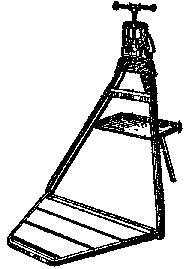
For practically any type of metal work, a vise, firmly attached to a solid workbench, is the first requirement. While there are many different makes and patterns of metal vises, there are two main types: the leg vise, shown in Fig. 1, and the parallel-jaw vise, Fig. 2. The leg vise is the older type, and is often preferred to the more modern parallel-jaw kind. It is usually made of mild steel or wrought iron, the jaws being faced with cast steel. It has the advantage of being more solid to work on than the parallel-jaw vise and will better withstand hard use. This type of vise is fixed to the bench by bolts through the strap, which is keyed to the leg (see Fig. 2). Always use bolts, never screws, to attach a vise to a bench, as a screw will not hold for long. The leg, or staple, is let into the floor or supported in a wooden block firmly attached to the floor, and this helps to give rigidity which is sometimes lacking in other types fixed only to the bench top. The shorter jaw is fixed to the leg by a hinge arrangement, and a square threaded screw is passed through this shorter jaw into a nut or box in, the long leg.' By turning the long handle provided, the shorter jaw is forced tightly against the other. As this is unscrewed, the jaws are opened by the pressure of a strong, flat spring between the two.

The construction of the leg vise with one jaw pivoted about the hinge makes the jaw work in an arc of a circle, and the jaws do not therefore remain parallel (see Fig. 3). This has a certain disadvantage when the work has to be gripped squarely for accurate filing. Another disadvantage is that if the work is to be held securely it must be gripped very tightly, because the jaws are frequently only gripping the work at the top or bottom. This pressure of the jaws of the vise may distort or damage the work. The parallel-jaw vise is now very widely used for all classes of metalworking. An example is shown in Fig. 4. The body and the sliding jaw are of cast iron, and the jaw plates, which are usually renewable, are of cast steel and are fixed to the casting by set screws.

Mounting a Vise. In attaching a vise to a bench, it should first be fitted so that it sits level; then it is bolted through the bench. The vise should be about 3 to 4 feet from the ground. A more accurate method of positioning is ensured by making the top of the vise equal in height to that of the worker's elbow from the floor when the arm is bent. This was explained in the section on Filing. In any event, it is better to have the vise a little too high than too low, as it is always possible to build a platform to bring the worker up to the best working position. Quick-Release Arrangements. Parallel vises are frequently designed to have an instantaneous grip. This means that the jaw can be moved in or out quickly by pressing a small lever and pulling or pushing the sliding jaw to the required position. The ordinary screw arrangement is then used to give the grip (see Fig. 4).


Fig. 5 shows a type of vise where the whole unit may be swivelled in a complete circle and firmly locked in any position by tightening two screws. This is a very useful feature, particularly in a small home workshop.
Another type of vise is designed especially for gripping pipes so that they may be threaded or cut off to length (Fig. 6). Ordinary parallel jaw vises can be provided with pipe jaws arranged below the parallel jaw-plates (Fig. 7) . While a plumber or steam fitter would naturally require the special pipe vise, the home craftsman can do the limited amount of pipe cutting and threading he undertakes with the parallel-jaw vise equipped with pipe jaws.
Pipe vises are either bolted to a bench or to a heavy plank or metal stand so they can be transported easily from one job to another.

For small delicate and decorative work, there are toolmaker's vises with jaws made of mild steel, and not serrated but case hardened.
The jaws of all machine vises are of hardened steel and are cut in a manner similar to a file, so that they will obtain a firm grip on the work. They will, however, seriously damage any light or finely polished work. To prevent cuts from marking the work, clamps are used, as explained under Filing. The hardened steel jaws on parallel-jaw vises are usually held in place by means of setscrews which are countersunk flush with the face of the jaws. It sometimes happens that the jaws break or they may in time become so worn that they no longer take a firm grip on the work.

The jaws are fitted so that renewal is possible. The greatest difficulty encountered in removing the jaws is to get the set screws out, as these are usually either rusted in tightly or have become bent -- thus making removal with a screwdriver difficult.

One easy way to remove these screws is to make a small improvised screwdriver and place it between the vise jaws so that the point of the screwdriver engages the slot of the screw head. The vise is then tightened to provide the necessary thrust and the screwdriver is turned by means of a wrench, as indicated in Fig. 8. As the screw is withdrawn, the vise jaws should be opened gradually. Generally speaking, however, once the screw has been started it will be possible to remove it with a regular screwdriver.



